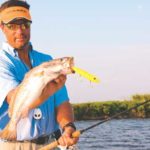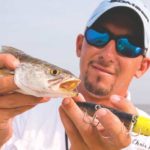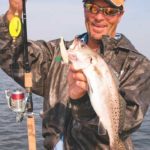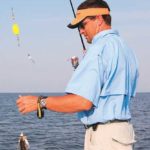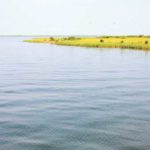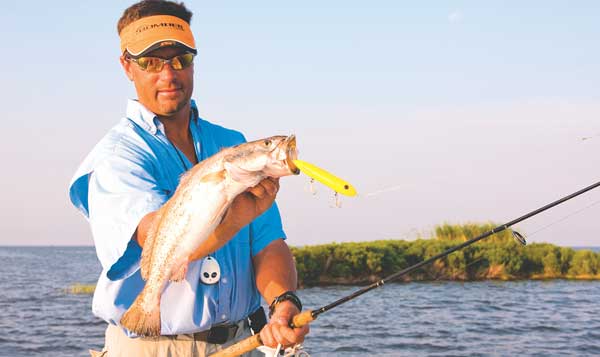
The northern horseshoe of Barataria Bay makes a lot of anglers look extraordinarily lucky this month.
How difficult would you find it to talk about fishing without saying the word luck?
“Having any luck?” a passing angler shouts.
“I would rather be lucky than good any day of the week,” a tournament winner sheepishly says from the stage.
“No luck,” an empty-handed angler fesses up to his wife.
Luck is as much a foundation for fishing fortunes as it is for gambling greatness. You might be a good angler, and you might be a good gambler, but without luck on your side, you’ll wind up just like all the other also-rans that nobody remembers.
There is a place just south of New Orleans, though, where saltwater anglers can change their fortunes for the better. It is a horseshoe-shaped stretch of salty water and sinking land that turns bad luck good. Better yet, you don’t need a rabbit’s food, you don’t need a four-leaf clover and you don’t need a charm. All you need is the Luck of Lafitte.
And the luckiest place in all of Lafitte is the northern rim of Barataria Bay during April. From the air, this uppermost stretch of Barataria Bay resembles a broad, sweeping horseshoe beginning at Bassa Bassa Bay to the west and running over to Bay Jimmy to the east.
The entire area is nothing more than a mass of oyster reefs, balls of bait and colliding water that attract and hold speckled trout that are trying to move south toward the coast — as long as the salinity is right within this horseshoe, which it typically is during April.
But then again, there are those who don’t believe in luck. They say luck is something that happens when preparation meets opportunity. Capt. Theophile Bourgeois may not pick up pennies off the street, but he has fished this area for many years, and he says this stretch of water is the opportunity for those that come prepared to fish it.
“Me? I fish nearly every day, so I just have to play the cards I’m dealt,” he said. “But if I could only fish a couple days a month, I would definitely try to preplan my trip to make it as productive as possible. I recommend watching the weather at least three days in advance of your trip looking specifically at the wind and the tidal range.”
Although the strong winds from March begin to subside somewhat this month, Bourgeois says that the typical southerly winds that prevail throughout much of April can be just as problematic because of the combination of how open Barataria Bay is and it’s steady rise from 10 to 12 feet of water down at Grand Lake to 3 to 4 feet near Manila Village and up to 1 to 2 feet right on top of the islands at the top of the bay.
“The thing you’ve got to worry about is how dirty the water is going to be,” Bourgeois continued. “Especially if those south and southeast winds are blowing up around 15. What happens is the shallow water that’s full of oysters will get dirty, and it will hold that dirty water a while.
“Five to 6 is not a problem … you can still see 2 feet down. Fifteen to 20 is going to turn the water into chocolate milk. If it blows that hard three days, it won’t matter what pocket you fish because it’s all going to be dirty.”
Understanding how the wind will affect the water and, therefore, the best fishing spots will go a long way toward successful speckled trout trips to Lafitte, but Bourgeois says that even more important may be the tidal range.
He pointed out that the most important consideration is a tidal range over 8/10ths of a foot. Anything less than that results in a very early bite that is typically over almost as quickly as it starts. The higher tidal ranges mean moving water over a longer period of time, and Bourgeois says you always want to fish the moving water.
“What happens with a good tide and a south wind is all that water will start bucking up against the shoreline all across this horseshoe at the top of Barataria Bay,” Bourgeois said. “That pushes all the weaker baitfish up against those shorelines, and where there are weak baitfish, there will be hungry speckled trout.”
Getting out of the wind by fishing the lee shore might make it more comfortable for you, but it might just put you fishing where there aren’t many fish. Bourgeois indicated that fishing the lee shoreline was way more important during the winter months than it is in April. However, depending on the wind direction and strength, you just might be lucky enough to get the best of both worlds.
The first thing Bourgeois does with normal south winds is fish all the oyster reefs along the ever-decreasing barrier islands that span the northern-most part of Barataria Bay. Since this is a rather long stretch of water, Bourgeois moves quickly until he locates big pockets of mullet or shad. If he doesn’t see any bait — no mullet or pogies flipping — he keeps moving even if the water looks good to him.
“Don’t even bother working pockets where you don’t see things in your favor,” he said. “When you find the bait, though, fish the points up to about 150 yards to the left and right. If you get enough bites, fine, go back and double dip it. If not, just keep hopping from point to point. You might catch a fish on your first cast to each point then nothing else. That’s fine. If that happens just fish 20 points and you got 20 fish.”
If the south wind starts to increase, Bourgeois simply moves to the backside of all those little points and islands from Bassa Bassa over to Bay Jimmy. If it gets up above 15, he ducks up into Wilkinson Bay, which is a labyrinth of islands and oyster reefs, and fishes the lower part of it. This maze of water and land offers anglers a lot more places to hide from the wind.
“This is where your preparation comes in,” Bourgeois said. “If you’ve been following the weather for three days before your trip, and it’s been blowing strong out of the south, then you know to stay away from the more open islands right at the rim of Barataria Bay — either that or run over to Cat Island to try to avoid the dirty-water issues.”
A strong east wind, which Bourgeois says is very likely during April, could be OK, as it would be running parallel to the shoreline at the very top of Barataria Bay. The key thing about an east wind, though, is that it will let you work all of Wilkinson Bay rather than just the lower part.
“Again, this is based on three days,” Bourgeois said. “If it’s been blowing from the south and it turns to the east that day, it won’t be an issue. The key is what direction the wind is blowing and how long it’s been blowing from that direction.”
Although a west wind won’t be as common during April as it was during March, Bourgeois said the wind blowing from the west is even better because this entire horseshoe area will be the lee shoreline. However, the stronger it gets, the more it will dictate where you will be most productive.
Capt. Chris Pike guides with Bourgeois Charters, and he pointed out Cabanash Cove as one of the most interesting and productive places to fish with a strong west wind. This high bank is a ridge right on the edge of the Barataria Waterway, and it gives lots of protection from a northwest, west or southwest wind. The chances of finding clear water here are a lot better than they would be over at Bay Batiste and Wilkinson Bay.
“Cabanash Cove catches a lot of water coming in from Four Bayou Pass,” Pike explained. “It comes right across Middle Bank and hits this high levee, so you get that water bucking up against it. And depending on how long and how strong the winds blow, you might want to look over toward Hackberry Bay.”
Any anglers who are feeling really luck should stick this horseshoe where the sun don’t shine, and head down to the backside of Grand Isle and Grand Terre, but with a strong South wind, Pike said to be prepared to get beaten up.
“If you have fuel and want to make the run, you can catch trout down there during April,” he said. “We cross Barataria Bay in 15- to 20-mph winds because we’re running 24-foot Champion bay boats. If you’re in a smaller boat, I wouldn’t recommend running down there anyway, but if you want to, at least stay in the Barataria Waterway to be a little protected.
“Of course the problem this time of year isn’t getting there as much as it is getting back because the wind often picks up later in the day. And you’re also dealing with a sea breeze down there. The weather might call for 8 to 10, but that means it’s going to be 15 down there.”
If you would rather be lucky than good, pick a day and go fishing. However, if you want to make your own luck, plan your Lafitte fishing trip at least three days ahead of time, and head for the horseshoe.
There’s your opportunity. Are you prepared?
Contact Bourgeois Fishing Charters at 504-341-5614 or www.neworleansfishing.com.
